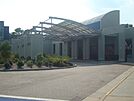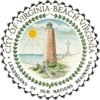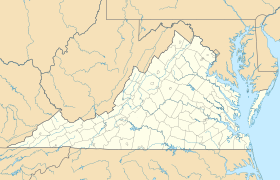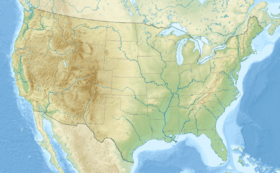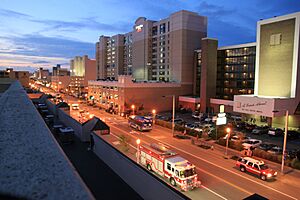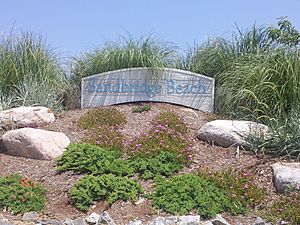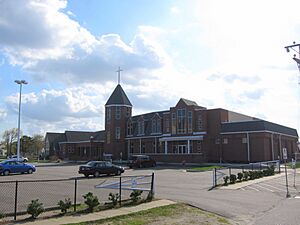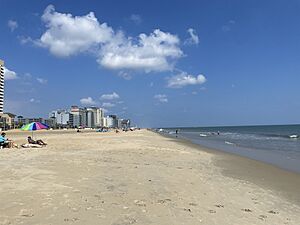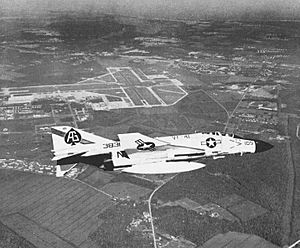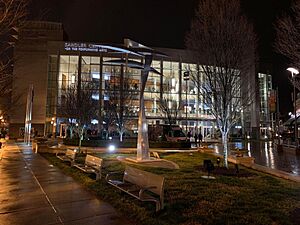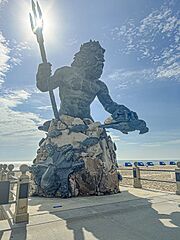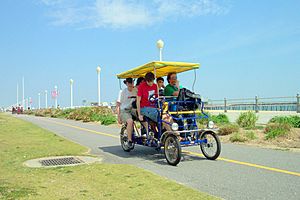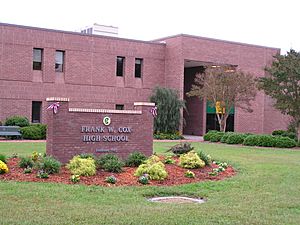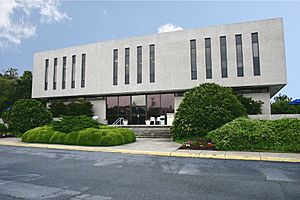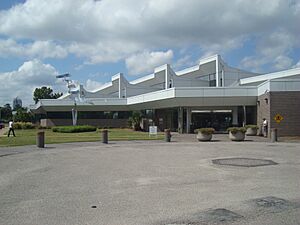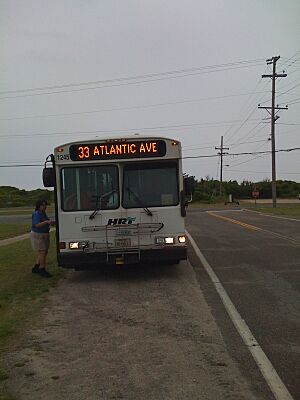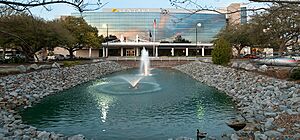Virginia Beach, Virginia facts for kids
Quick facts for kids
Virginia Beach
|
|||||
|---|---|---|---|---|---|
|
Cape Henry Lighthouses
Cavalier Hotel
Regent University
Virginia Beach Town Center
|
|||||
|
|||||
| Nickname(s):
"The Resort City", VA Beach
|
|||||
| Motto(s):
Landmarks of Our Nation's Beginning
|
|||||
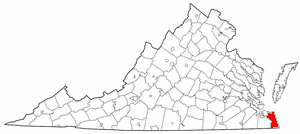
Virginia Beach in Virginia
|
|||||
| Country | United States | ||||
| State | Virginia | ||||
| Incorporated (town) | 1906 | ||||
| Incorporated (city) | 1952 | ||||
| Government | |||||
| • Type | Mayor–council–manager | ||||
| • Body | Virginia Beach City Council | ||||
| Area | |||||
| • Independent city | 497.50 sq mi (1,288.52 km2) | ||||
| • Land | 244.72 sq mi (633.83 km2) | ||||
| • Water | 252.78 sq mi (654.69 km2) | ||||
| Elevation | 10 ft (3 m) | ||||
| Population
(2020)
|
|||||
| • Independent city | 457,672 |
||||
| • Rank | US: 42nd VA: 1st |
||||
| • Density | 1,877.53/sq mi (724.92/km2) | ||||
| • Urban | 1,451,578 (US: 36th) | ||||
| • Urban density | 3,013.6/sq mi (1,163.6/km2) | ||||
| • Metro | 1,799,674 (US: 37th) | ||||
| Demonym(s) | Virginia Beachian (unofficial) | ||||
| GDP | |||||
| • Independent city | $29.532 billion (2023) | ||||
| • Metro | $127.459 billion (2023) | ||||
| Time zone | UTC−05:00 (EST) | ||||
| • Summer (DST) | UTC−04:00 (EDT) | ||||
| ZIP Codes |
23450-23467, 23471, 23479
|
||||
| Area code(s) | 757, 948 | ||||
| FIPS code | 51-82000 | ||||
| GNIS feature ID | 1500261 | ||||
Virginia Beach, officially called the City of Virginia Beach, is the largest city in Virginia by population. In 2020, about 459,470 people lived there. It is on the southeastern coast of Virginia, where the Atlantic Ocean meets the Chesapeake Bay. Virginia Beach is a main city in the Hampton Roads area, which has over 1.8 million people.
Virginia Beach is a popular resort city. It has many miles of beaches and lots of hotels, motels, and restaurants along its oceanfront. Near Cape Henry, English colonists first landed in 1607 before settling in Jamestown. Modern Virginia Beach was founded in 1906.
The city has several state parks, protected beaches, and military bases. Important places like Virginia Wesleyan University, Regent University, and the U.S. headquarters of Stihl are here. Virginia Beach also hosts big events like the annual East Coast Surfing Championships and Neptune Festival.
The city is famous for having the longest pleasure beach in the world, according to the Guinness Book of Records. It is also at the southern end of the Chesapeake Bay Bridge-Tunnel. This was once the world's longest bridge-tunnel complex.
Contents
History of Virginia Beach
Long ago, the Chesepian people lived in the area now known as Virginia Beach. They were a Native American tribe. Not much is known about them, but they likely spoke an Algonquian language. Many tribes along the coast spoke these languages. They were part of the larger Powhatan Confederacy.
In 1607, three English ships arrived in the New World. They were led by Captain Christopher Newport. They first landed at the southern mouth of the Chesapeake Bay, which they named Cape Henry. This was named after Prince Henry, the son of King James I of England. The colonists then moved inland to create their first permanent settlement at Jamestown.
Adam Thoroughgood (1604–1640) was one of the first Englishmen to settle in this area. He came to Virginia as an indentured servant at age 18. After earning his freedom, he became an important citizen. In 1629, he was elected to the House of Burgesses. This was an early form of government.
In 1634, the Virginia Colony was divided into counties. Thoroughgood helped name "New Norfolk County" after his home in England. Later, this county split into Upper Norfolk County and Lower Norfolk County. Thoroughgood lived near the Lynnhaven River, also named after a place in England.
Lower Norfolk County was very large. It covered the areas of modern-day Portsmouth, Norfolk, Chesapeake, and Virginia Beach. In 1691, Lower Norfolk County was divided again. This created Norfolk and Princess Anne counties. Princess Anne County existed for over 250 years. It included all the land along the Atlantic Ocean.
In the late 1800s, Virginia Beach began to grow as a small resort area. This happened after a railroad arrived in 1883. The Virginia Beach Hotel opened near the oceanfront. It later became the Princess Anne Hotel.
In 1891, hotel guests saw the rescue of a ship called the Dictator. Its figurehead washed ashore and became a monument. Today, two matching Norwegian Lady Monuments stand in Virginia Beach and Moss, Norway.
The resort first relied on trains and trolleys. But when Virginia Beach Boulevard opened in 1922, more people came by car. Train service to the oceanfront stopped. Virginia Beach became an incorporated town in 1906. It grew as a popular vacation spot. In 1927, The Cavalier Hotel opened and became very popular.
Virginia Beach became an independent city in 1952. In 1963, Virginia Beach and Princess Anne County joined together. The new, larger city kept the name Virginia Beach.
The Alan B. Shepard Civic Center, also known as "The Dome," was built in 1958. Many famous musicians played there. It was named after astronaut Alan Shepard, who lived in Virginia Beach. The building was taken down in 1994.
Modern Virginia Beach Development
Today, real estate, defense, and tourism are big parts of Virginia Beach's economy. Many groups work together on building projects. Examples include the Virginia Beach Convention Center and the Virginia Beach Town Center. The Town Center opened in 2003, and the Convention Center opened in 2005.
The city is running out of empty land for new buildings. This has caused some challenges for Naval Air Station Oceana. This is a major U.S. Navy fighter jet base. The city supports the airbase.
Heavy rainfall from Hurricane Matthew caused flooding in over 2000 homes. Some neighborhoods had standing water for days. Because of this, the city has been more careful about building in flood-prone areas.
Geography of Virginia Beach

Virginia Beach is located at 36°51′02″N 75°58′40″W / 36.8506°N 75.9779°W.
The city covers about 497 square miles (1,288 km2). About 249 square miles (645 km2) is land, and 248 square miles (642 km2) is water. It is the largest city in Virginia by total area. Much of the city's water flows into the Chesapeake Bay through the Lynnhaven River.
Virginia Beach is in the southeastern corner of Virginia. It borders the Atlantic Ocean. The Hampton Roads area is the 37th largest in the U.S. with 1.7 million people. Virginia Beach is the most populated city in this area.
Virginia Beach is about 19 miles (31 km) east of Norfolk, Virginia. It is also 208 miles (335 km) south of Washington, D.C..
Virginia Beach Neighborhoods
When Virginia Beach became a larger city in 1963, it was divided into seven areas. These were Bayside, Blackwater, Kempsville, Lynnhaven, Princess Anne, Pungo, and Virginia Beach.
Virginia Beach has many unique communities and neighborhoods. Some of these include Alanton, Aragona Village, Bay Colony, Chesapeake Beach, Croatan Beach, Green Run, Kempsville, Lynnhaven, Oceana, Princess Anne, Pungo, and Sandbridge.
Virginia Beach Climate
| Weather chart for Virginia Beach, VA | |||||||||||||||||||||||||||||||||||||||||||||||
|---|---|---|---|---|---|---|---|---|---|---|---|---|---|---|---|---|---|---|---|---|---|---|---|---|---|---|---|---|---|---|---|---|---|---|---|---|---|---|---|---|---|---|---|---|---|---|---|
| J | F | M | A | M | J | J | A | S | O | N | D | ||||||||||||||||||||||||||||||||||||
|
3.6
49
30
|
3.5
52
32
|
4.1
60
38
|
3.5
69
47
|
3.8
77
56
|
4
85
65
|
5.1
88
69
|
5.2
86
68
|
4.7
81
61
|
3.5
71
50
|
3.3
62
41
|
3.6
53
33
|
||||||||||||||||||||||||||||||||||||
| temperatures in °F precipitation totals in inches |
|||||||||||||||||||||||||||||||||||||||||||||||
|
Metric conversion
|
|||||||||||||||||||||||||||||||||||||||||||||||
Virginia Beach has a humid subtropical climate. This means it has mild to warm weather for most of the year. Summers are often hot and humid. They have short thunderstorms in the late afternoon. Winters are cool with little snow.
The average yearly temperature is about 59.6°F (15.3°C). The city gets about 47 to 50 inches (1,190 to 1,270 mm) of rain each year. August is usually the wettest month. Virginia Beach gets about 2200 hours of sunshine every year. This is more than the average for the USA.
The highest temperature ever recorded was 105°F (41°C) in July 2010. The lowest was -3°F (-19°C) in January 1985.
Because of the Chesapeake Bay and the Atlantic Ocean, Virginia Beach has a milder climate. This allows many subtropical plants to grow here. For example, Spanish moss grows well in First Landing State Park.
On April 30, 2023, a strong tornado hit the Great Neck neighborhood. It was an EF-3 tornado. Luckily, no one was killed or hurt. This was the strongest tornado ever recorded in the city.
| Climate data for Norfolk International Airport, Virginia (1981–2010 normals, extremes 1874–present ) | |||||||||||||
|---|---|---|---|---|---|---|---|---|---|---|---|---|---|
| Month | Jan | Feb | Mar | Apr | May | Jun | Jul | Aug | Sep | Oct | Nov | Dec | Year |
| Record high °F (°C) | 84 (29) |
82 (28) |
92 (33) |
97 (36) |
100 (38) |
102 (39) |
105 (41) |
105 (41) |
100 (38) |
95 (35) |
86 (30) |
82 (28) |
105 (41) |
| Mean maximum °F (°C) | 71.1 (21.7) |
73.2 (22.9) |
80.2 (26.8) |
86.4 (30.2) |
91.4 (33.0) |
95.5 (35.3) |
97.8 (36.6) |
95.8 (35.4) |
92.1 (33.4) |
85.6 (29.8) |
78.7 (25.9) |
72.5 (22.5) |
98.8 (37.1) |
| Mean daily maximum °F (°C) | 48.1 (8.9) |
50.9 (10.5) |
58.2 (14.6) |
67.6 (19.8) |
75.4 (24.1) |
83.5 (28.6) |
87.4 (30.8) |
85.1 (29.5) |
79.3 (26.3) |
70.1 (21.2) |
61.1 (16.2) |
52.1 (11.2) |
68.3 (20.2) |
| Mean daily minimum °F (°C) | 32.7 (0.4) |
34.4 (1.3) |
40.5 (4.7) |
48.9 (9.4) |
57.9 (14.4) |
67.1 (19.5) |
71.9 (22.2) |
70.7 (21.5) |
65.3 (18.5) |
54.0 (12.2) |
44.6 (7.0) |
36.1 (2.3) |
52.1 (11.2) |
| Mean minimum °F (°C) | 17.6 (−8.0) |
21.2 (−6.0) |
27.2 (−2.7) |
35.7 (2.1) |
45.7 (7.6) |
55.5 (13.1) |
63.1 (17.3) |
61.6 (16.4) |
53.7 (12.1) |
39.7 (4.3) |
30.5 (−0.8) |
21.7 (−5.7) |
15.2 (−9.3) |
| Record low °F (°C) | −3 (−19) |
2 (−17) |
14 (−10) |
23 (−5) |
36 (2) |
45 (7) |
54 (12) |
49 (9) |
40 (4) |
27 (−3) |
17 (−8) |
5 (−15) |
−3 (−19) |
| Average precipitation inches (mm) | 3.40 (86) |
3.12 (79) |
3.68 (93) |
3.41 (87) |
3.41 (87) |
4.26 (108) |
5.14 (131) |
5.52 (140) |
4.76 (121) |
3.42 (87) |
3.15 (80) |
3.26 (83) |
46.53 (1,182) |
| Average snowfall inches (cm) | 2.4 (6.1) |
2.0 (5.1) |
0.2 (0.51) |
trace | 0 (0) |
0 (0) |
0 (0) |
0 (0) |
0 (0) |
0 (0) |
trace | 1.2 (3.0) |
5.8 (15) |
| Average precipitation days (≥ 0.01 in) | 10.4 | 9.5 | 10.6 | 10.1 | 10.6 | 9.9 | 11.1 | 10.1 | 8.8 | 7.6 | 8.5 | 9.8 | 117.0 |
| Average snowy days (≥ 0.1 in) | 1.6 | 1.3 | 0.4 | 0.1 | 0 | 0 | 0 | 0 | 0 | 0 | 0 | 0.6 | 4.0 |
| Average relative humidity (%) | 66.3 | 65.6 | 64.6 | 62.8 | 68.8 | 70.6 | 73.3 | 75.2 | 74.4 | 72.1 | 68.5 | 67.0 | 69.1 |
| Mean monthly sunshine hours | 171.5 | 175.2 | 229.3 | 252.8 | 271.7 | 280.1 | 278.3 | 260.4 | 231.4 | 208.3 | 175.7 | 160.4 | 2,695.1 |
| Percent possible sunshine | 56 | 58 | 62 | 64 | 62 | 64 | 62 | 62 | 62 | 60 | 57 | 53 | 61 |
| Source: NOAA (relative humidity and sun 1961–1990) | |||||||||||||
People of Virginia Beach
| Historical population | |||
|---|---|---|---|
| Census | Pop. | %± | |
| 1910 | 320 | — | |
| 1920 | 846 | 164.4% | |
| 1930 | 1,719 | 103.2% | |
| 1940 | 2,600 | 51.3% | |
| 1950 | 5,390 | 107.3% | |
| 1960 | 8,091 | 50.1% | |
| 1970 | 172,106 | 2,027.1% | |
| 1980 | 262,199 | 52.3% | |
| 1990 | 393,069 | 49.9% | |
| 2000 | 425,257 | 8.2% | |
| 2010 | 437,994 | 3.0% | |
| 2020 | 459,470 | 4.9% | |
| U.S. Decennial Census 1790–1960 1900–1990 1990–2000 2010–2020 |
|||
Population and Diversity
As of 2022[update] American Community Survey estimates, Virginia Beach had about 455,618 people. There were 179,752 households. The population density was about 1,862 people per square mile.
About 60.3% of the people were White. 18.8% were Black or African American. 7.2% were Asian. About 10.3% were from two or more races. Hispanics or Latinos made up 9.0% of the population.
About 30.0% of households had children under 18. 29.2% had seniors aged 65 or older. The average household size was 2.49 people. The average family size was 3.08 people.
The median age in Virginia Beach was 37.8 years. About 21.7% of the population was under 18. 16.1% were 65 or older.
The median income for a household was $83,245. For families, it was $103,451. The average income per person was $44,287. About 10.0% of people lived below the poverty line.
Many residents have English, German, and Irish backgrounds.
Religious Groups
About 34.4% of people in Virginia Beach belong to religious groups. There are 146,402 members in 184 different religious groups.
- 28% are Catholic.
- 14% are Southern Baptist.
- 13% are United Methodist.
- 12% are Independent Charismatic Churches.
- 33% belong to other groups.
Economy of Virginia Beach
Virginia Beach has many different types of businesses. These include large company headquarters, factories, defense companies, and local shops. Its location makes it a good place for international trade. Almost 200 foreign companies have offices here. Twenty international firms have their U.S. or North American headquarters in Virginia Beach. These include Stihl, London Bridge Trading Company, and Busch Vacuum Solutions.
Other big companies based in Virginia Beach are Amerigroup, the Christian Broadcasting Network, and Operation Blessing International. Major employers also include GEICO and Navy Exchange Service Command. In September 2023, Amazon announced it would build two new delivery centers in Virginia Beach. Forbes ranked Virginia Beach as the 45th best place for business and careers.
Tourism is a huge part of Virginia Beach's economy. Visitors spend about $857 million in tourism-related businesses. This creates 14,900 jobs. The city earns about $73 million in revenue from visitors. The Virginia Beach Convention Center opened in 2005 for large meetings. Hotels are found along the oceanfront and in other parts of the city. Restaurants and entertainment also benefit from tourism.
Virginia Beach also has a large farming business. This brings in $80 million for the city. There are 172 farms, mostly in the southern part of the city. Farmers sell their products at the city's Farmer's Market.
Virginia Beach is home to several United States Military bases. These include the United States Navy's NAS Oceana and Training Support Center Hampton Roads. The Joint Expeditionary Base East is at Cape Henry. NAB Little Creek is also mostly in Virginia Beach.
NAS Oceana is the largest employer in Virginia Beach. Both NAS Oceana and Training Support Center Hampton Roads are considered the largest of their kind in the world. Also, the main base for the U.S. Navy's Atlantic Fleet, Naval Station Norfolk, is nearby in Norfolk.
About 54% of people working in Virginia Beach live in the city. The unemployment rate has dropped a lot in recent years.
Culture and Fun in Virginia Beach
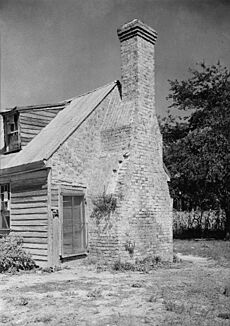
Virginia Beach has many interesting places for history, science, and arts. It has become a popular place for tourists. The Virginia Museum of Contemporary Art shows different types of art. These include paintings, sculptures, and photos from famous artists. The museum started from the annual Boardwalk Art Show in 1952.
The Virginia Aquarium & Marine Science Center is a popular aquarium near the oceanfront. It has many sea animals like sharks, sting rays, sea turtles, and octopuses.
One of the world's largest collections of World War I and World War II planes is at the Military Aviation Museum. This museum is in the Pungo area of Virginia Beach.
The Veterans United Home Loans Amphitheater at Virginia Beach opened in 1996. It hosts many popular shows and concerts. The Sandler Center, a theater with 1200 seats, opened in the Virginia Beach Town Center in 2007.
Virginia Beach has many important historical sites. There are 18 sites on the National Register of Historic Places. These include the Adam Thoroughgood House, which is one of the oldest colonial homes in Virginia. Other sites are the Francis Land House and the Cape Henry Lights.
The Edgar Cayce Hospital for Research and Enlightenment was built in Virginia Beach in 1928. It has a large library about psychic topics. It is open to the public. Cayce also opened Atlantic University in 1930.
The city's biggest festival is the Neptune Festival. It brings 500,000 visitors to the oceanfront. It also has an air show at NAS Oceana. This festival celebrates the city's connection to Norway. It happens in September. Every Labor Day Weekend, the American Music Festival has live music on stages along the oceanfront.
Sports and Recreation
| Club | League | Venue | Established |
|---|---|---|---|
| Virginia Beach United FC | USL League Two Soccer | Virginia Beach Sportsplex | 2019 |
Most major sports teams in the Hampton Roads area are in Norfolk. The area has been considered for major professional sports teams. But no team has moved here yet. Hampton Roads is the largest metropolitan area in the U.S. without a major professional sports team.
The Norfolk Admirals won the AHL Calder Cup in 2012.
The Virginia Destroyers, a football team, played at the Virginia Beach Sportsplex until 2012. Two soccer teams, the Virginia Beach Piranhas (men's) and the Hampton Roads Piranhas (women's), play at the Sportsplex. The Virginia Beach Sportsplex is also a training site for the U.S. women's national field hockey team.
The city hosts the East Coast Surfing Championships. This is an annual contest with over 100 professional surfers. It is North America's oldest surfing contest.
There are eleven golf courses open to the public in Virginia Beach. There are also four country club courses and 36 military holes at NAS Oceana.
Virginia Beach hosts a Rock 'n' Roll Half Marathon every year. It is one of the largest half marathons in the world. The city also hosts the Yuengling Shamrock Marathon. This race has over 24,000 participants.
In the 1980s, Virginia Beach was known for building the first skateboard ramps funded by a city. As of 2024, the city has three skateparks: Mount Trashmore Skatepark, Williams Farm Skatepark, and Woodstock Park Skate Plaza.
Parks and Outdoor Fun
Virginia Beach has 210 city parks. They cover over 4,000 acres (1,600 hectares). These include neighborhood parks, community parks, and other open spaces.
Mount Trashmore Park is easy to see from I-264. The hill is 60 feet (18 meters) high. It is the highest point in Virginia Beach.
Red Wing Park is a major park with 97 acres (39 hectares). It is in the east-central part of the city. A special part of this park is the Miyazaki Japanese Garden. This garden shows the connection with Virginia Beach's sister city, Miyazaki, Japan.
The Back Bay National Wildlife Refuge was created in 1938. It is an 8,000-acre (3,200-hectare) freshwater refuge. It borders the Atlantic Ocean. It is managed by the U.S. Fish and Wildlife Service.
First Landing State Park and False Cape State Park are also in Virginia Beach.
Munden Point Park is a rural park in the southern part of the city. It is on The North Landing River.
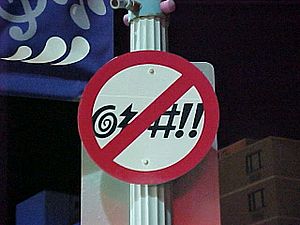
Pleasure House Point is a 118-acre (48-hectare) park of undeveloped land. It is on the shore of the Lynnhaven River.
Virginia Beach's park system is one of the best in the U.S. In 2013, The Trust for Public Land ranked Virginia Beach's park system as the 8th best among the 50 largest U.S. cities.
Education in Virginia Beach
About 28.1% of people over 25 in Virginia Beach have a bachelor's degree or higher. This is more than the national average. Also, 90.4% have a high school diploma.
Before 1969, schools were separate for black and white students. In 1938, the first high school for black students, Princess Anne County Training School, was built. It was later renamed Union Kempsville High School. When schools became integrated in 1969, Union Kempsville closed.
The city of Virginia Beach has Virginia Beach City Public Schools. This is one of the largest school systems in Virginia. It serves about 69,735 students. It has 56 elementary schools, 14 middle schools, and 12 high schools. Some high schools are Landstown, Princess Anne, Cox, and Ocean Lakes. There are also special schools like the Advanced Technology Center.
There are also private schools in the city. These include Chesapeake Bay Academy, Cape Henry Collegiate School, and Catholic High School.
Virginia Beach has three universities. Atlantic University is a learning institution founded in 1930. Regent University is a private university founded by Pat Robertson. It focuses on higher education. Virginia Wesleyan University is a private university founded in 1961.
Old Dominion University and Norfolk State University are nearby in Norfolk. But they have a joint center in Virginia Beach. The University of Virginia and Virginia Tech also have campuses here. Tidewater Community College, a large junior college, has its biggest campus in the city.
The Virginia Beach Public Library System offers free access to information. It has over 1 million items.
Media and News
The Virginian-Pilot, based in Norfolk, is the daily newspaper for Virginia Beach. Other local papers include Veer and the New Journal and Guide. Inside Business covers local business news.
The Hampton Roads area has many radio stations. Virginia Beach also has several television stations. The main TV channels are WTKR (CBS), WAVY-TV (NBC), WVEC (ABC), and WVBT (Fox). The public broadcasting station is WHRO-TV. Virginia Beach residents can also get WSKY from North Carolina.
Virginia Beach is the headquarters for the Christian Broadcasting Network. Their famous show, The 700 Club, is made here.
City Services
Transportation in Virginia Beach
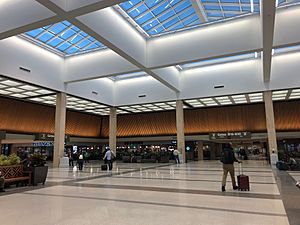
Virginia Beach mainly uses the Norfolk International Airport. This is the main airport for the region. The airport is near the Chesapeake Bay, close to Norfolk. The Newport News/Williamsburg International Airport also serves the area. The Chesapeake Regional Airport is for private planes.
Virginia Beach Airport is a small airport for private aircraft.
For train travel, Virginia Beach is served by Amtrak. You can get to the Norfolk and Newport News stations by bus.
Greyhound/Trailways provides bus service from Norfolk. The Greyhound station in Virginia Beach is on Laskin Road.
The city is connected to I-64 by I-264. This highway runs from the oceanfront and connects to other cities. Other major roads include Virginia Beach Boulevard (U.S. Route 58) and Shore Drive (U.S. Route 60).
The city is also connected to Virginia's Eastern Shore by the Chesapeake Bay Bridge-Tunnel (CBBT). This is the longest bridge-tunnel complex in the world. It carries U.S. Route 13.
Transportation within the city is handled by Hampton Roads Transit, a regional bus service. There are plans to extend the The Tide light rail system from Norfolk to the oceanfront.
Utilities and Services
The City's Department of Utilities provides water and sewer services. Virginia Beach gets its electricity from Dominion Virginia Power. This power comes from local plants and nuclear power. Virginia Natural Gas provides natural gas to the city.
Water for the area comes from Lake Gaston and other rivers. The city handles wastewater services.
Broadband internet service is provided by Cox Communications. Verizon also offers its Fios internet service in some areas.
Healthcare
Virginia Beach has two main hospitals: Sentara Virginia Beach General Hospital and Sentara Princess Anne Hospital. The former Sentara Bayside Hospital is now an emergency and outpatient center. Sentara Leigh Hospital is just over the city line in Norfolk. The Beach Health clinic offers basic medical services for people without health insurance.
Sister Cities
Virginia Beach has special connections with other cities around the world. These are called sister cities:
 Bangor, County Down, Northern Ireland, United Kingdom (2001)
Bangor, County Down, Northern Ireland, United Kingdom (2001) Miyazaki, Japan (1992)
Miyazaki, Japan (1992) Moss, Norway (1974)
Moss, Norway (1974) Olongapo, Philippines (2015)
Olongapo, Philippines (2015) Waiblingen, Germany (2016)
Waiblingen, Germany (2016)
Friendly Cities
Virginia Beach also has friendly relations with:
 San Juan del Sur, Nicaragua (1974)
San Juan del Sur, Nicaragua (1974)
Famous People from Virginia Beach
Many notable people have connections to Virginia Beach, including:
- Plaxico Burress, NFL player and Super Bowl Champion.
- Gabby Douglas, Olympic gymnastics gold medalist.
- Percy Harvin, NFL player.
- Marc Leishman, professional golfer.
- EJ Manuel, NFL quarterback.
- Bob McDonnell, former Governor of Virginia.
- Kára McCullough, winner of Miss USA 2017.
- Juice Newton, singer and songwriter.
- Derrick Nnadi, NFL defensive tackle.
- Pusha T, rapper.
- David Robinson, NBA legend and Olympic gold medalist.
- Mark Ruffalo, Oscar-nominated actor.
- Rhea Seehorn, actress.
- Chris Taylor, MLB player.
- Timbaland, music producer.
- Pharrell Williams, rapper, singer, and producer.
- Glenn Youngkin, Governor of Virginia.
- Ryan Zimmerman, MLB player.
See also
 In Spanish: Virginia Beach para niños
In Spanish: Virginia Beach para niños








